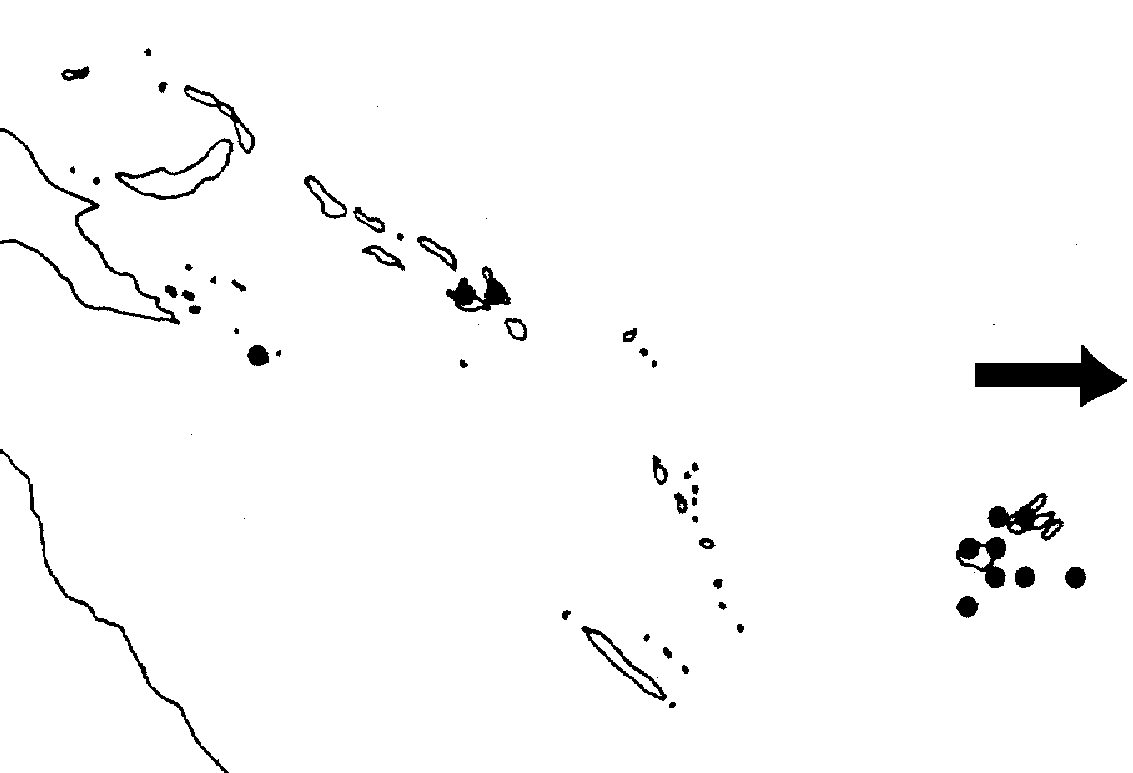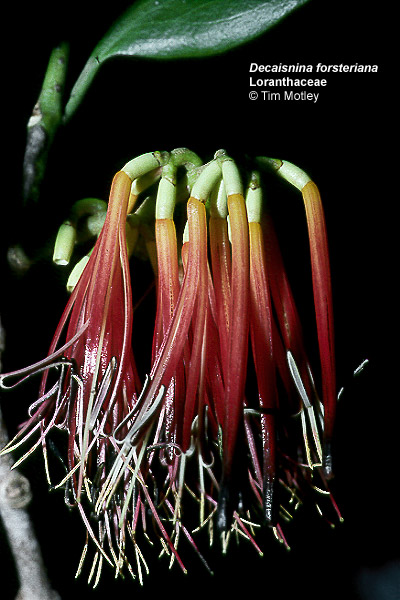
Distribution Map

Description (Barlow 1993)
Decaisnina forsteriana (J.A. Schultes & J. Schultes) Barlow
Loranthus forsterianus J.A. Schultes & J. Schultes, Syst. 7,2 (1830) 1612,1730. - Decaisnina forsteriana (J.A. Schultes & J. Schultes) Barlow in D.Walker (ed.), Bridge and Barrier, Austral. Nat. Univ. Publ. BG/3 (1972) 185. - Type: Forster 76 (holo P), Tahiti.
For description and extensive synonymy see Barlow, Austral. J. Bot. 22 (1974) 537. Decaisninaforsteriana has few specialized characters, and thus presents a relatively generalized facies for the genus. The species can be identified by its combination of distinctly petiolate, thin, weakly bifacial leaves dull on both sides, triads with lateral flowers shortly pedicellate, corollas usually more than 35 mm long, and anthers with slender transverse septa which usually fracture at anthesis. The flower colour is predominantly bright red, often darker towards the tip, but predominantly yellow flowers are recorded from the Solomon Islands, Tonga and Samoa.
Decaisnina forsteriana is widely distributed in South Pacific islands from New Guinea (Louisiade Archipelago) eastwards to Tahiti and the Marquesas (Fig. 5; 54 collections seen), recorded at elevations from sea level to 1900 m but apparently most common in upland situations, The species is exceptional in the family for its wide distribution to oceanic islands, Additional collections seen in the present study have extended the known area of the species westwards from the Solomon Is to Misima I, Papua New Guinea. Habitat details are poorly known, although the species has been recorded in humid forests; it is recorded as parasitic on various hosts including Diospyros, Ficus, Grewia, Homalanthus, Inocarpus, Metrosideros, Pittosporum, and Wikstroemia.
The affinities of D. forsteriana appear to be with the Australian and several New Guinean species with which it shares a non-inflated corolla base, relatively long corolla, and triads evenly spaced along the inflorescence axis. It is possibly closely related to D. longipes which also has long petioles and pedicellate lateral flowers in the triads. It differs from D. longipes in its smaller thinner leaves and finely transversely septate anthers.
Description (Barlow 1974)
Decaisnina forsteriana (Schult.) Barlow, Aust. Nat. Univ. Pubi. BG/3, p. 185 (1972); Loranthus forsterianus Schult. Syst. Veg. 7, 2: 1612, 1730 (1830); Dendrophthoe forsteriana (Schult.) G. Don, Gen. Hist. 3: 419 (1834); Treubella forsteriana (Schult.) Tiegh. Bull. Soc. bot. Fr. 41: 266 (1894) nom. illeg.; Elytranthe forsteriana (Schult.) Engl. Pfl. Fam. Nachtr. 126 (1897); Amylotheca forsteriana (Schult.) Dans. Bull. Jard. bot. Buitenz. 10: 301 (1929); 14: 74(1936). Type.-Tahiti, Forster 76 (P).
Loranthus insularum A. Gray, U.S. Expl. Exped. Bot. 1: 738, illus. Fig. 98 (1854); Treubella insularum (A. Gray) Tiegh. Bull. Soc. bot. Fr. 42: 435 (1895) nom. illeg.; Elytranthe insularum (A. Gray) EngI. Pfl. Earn. Nachtr. 126 (1897); Amylotheca insularum (A. Gray) Dans. Bull. Jard. bot. Buitenz. 10: 301 (1929); 14: 76 (1936). Type.-Fiji, U.S. Expi. Exped., 1838-1842 (GH, holotype, not seen; NY).
Loranthus vitiensis Seemann, Fl. vit. 120, illus. Fig. 23 (1865); Treubella vitiensis (Seemann) Tiegh. Bull. Soc. bot. Er. 41: 267 (1894) nom. illeg.; Elytranthe vitiensis (Seemann) Engl. Pfl. Fam. Nachtr. 126 (1897); Amylotheca vitiensis (Seemann) Dans. Bull. Jard. bot. Buitenz. 10: 303 (1929). Type.-Fiji, Seemann 210, 1860 (P).
Treubella spathulata Tiegh. Bull. Soc. bot. Fr. 42: 435 (1895) nom. illeg.; Arnylotheca spathulata (Tiegh.) Dans. Bull. Jard. bot. Buitenz. 10: 302 (1929); 14: 85 (1936). Type.-Not seen. Stated by van Tieghem to be in (P) without indication of locality or collector.
Amylotheca mercieri (Tiegh.) Dans. Bull. Jard. bot. Buitenz. 14: 78 (1936); Treubella mercieri Tiegh. Bull. Soc. bot. Er. 42: 435 (1895) nom. nud., norn. illeg. Type. Marquesas, Nouka Hiva, Mercier, 1847 (P).
Glabrous or rarely with a very sparse and scattered tomentum at the bases of the leaves. Stems slender, more or less flattened and double-edged when very young, soon becoming terete. Petiole slender, 1-2 cm long; lamina ovate, 5-7-(9) by 2.5-4 cm, more or less shining above, dull below, attenuate at the base, recurved at the margin, acute to rounded at the apex; venation distinct on both surfaces, pennate but sometimes with the lower lateral veins almost curvinervous. Inflorescences usually solitary in the axils; axis angular, usually bearing 4 pairs of triads, 2-3 cm long, c. 2 mm thick; peduncles of the triads 4-6 mm long; pedicels of the lateral flowers of the triads (0.5)-1-2 mm long; bracts irregular in shape, often serrate, often truncate, 1-1.5mm long. Calyx cylindrical, (2)-3-3.5 mm long; limb entire or irregularly split, spreading, 1 mm long. Corolla in the mature bud (25)-35-45 mm long; petals in the open flower usually separating to the base but sometimes coherent in the lower 1 mm or rarely more. Anthers transversely septate, 2-3-(5) mm long, usually slightly shorter than the free parts of the filaments. Style articulate c. 0.5 mm above the base. Fruit nearly globular, not seen mature.
Occurrence. Solomon Islands, Fiji, Tonga, Samoa, Cook Islands, Tahiti and Marquesas Islands (Fig. 4). This species has the widest distribution over oceanic islands of all Loranthaceae.
Representative Specimens. SOLOMON ISLANDS: Santa Ysabel, near Maringe Lagoon, Mt. Sasari, 730 m alt., Whitmore BSIP 2424, 26.x.1963 (L). FIJI: Viti Levu, between Nandrau and Rewasu, 725-825 rn alt., Smith 5409, 31.vii.-1l.viii.1947 (L). SAMOA: Samoa, Reinecke 1599, Dec. 1894 (L). TAHITI: Tahiti, Vesco, 1847 (L).
See note under D. hollrungii.
Illustrations
Loranthus insularum A. Gray, U.S. Expl. Exped. Bot. 1: 738, illus. Fig. 98 (1854)
Loranthus vitiensis Seemann, Fl. vit. 120, illus. Fig. 23 (1865)
Photographs

Decaisnina forsteriana
updated 19 January 2007